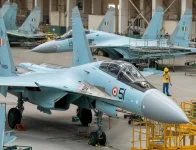- Views: 1K
- Replies: 7
India's long-standing reliance on foreign military hardware is creating a significant strategic vulnerability, particularly as its primary regional rival, China, aggressively pursues indigenous modernisation.
This "buy, not build" approach to defence procurement has been criticized for fostering dependency and failing to deliver platforms engineered to meet India's specific long-term security challenges.
The most immediate consequence is visible in the Indian Air Force (IAF). As of late 2025, the IAF's combat fleet has fallen to approximately 30 squadrons, far short of the 42 squadrons sanctioned by the government as necessary to manage a potential two-front conflict.
This gap, exacerbated by the retirement of aging fleets like the MiG-21, highlights a procurement process that has struggled to replace outgoing aircraft at a sufficient pace.
This challenge stems from a historical preference for importing high-value platforms, such as the French Rafale or Russian Su-30MKI, over the difficult, long-term development of domestic solutions.
In stark contrast, China’s People's Liberation Army Air Force (PLAAF) has invested heavily in its own research and development. This sustained state-directed effort has allowed China to rapidly design, test, and mass-produce advanced aircraft. A clear example is the Chengdu J-20 stealth fighter, with estimates placing its operational numbers at over 300 aircraft in service.
The Tejas Program: A Case Study in Delays
The development of India's indigenous Light Combat Aircraft (LCA) Tejas epitomizes this struggle. The program, which began in the 1980s to create a homegrown replacement for the MiG-21, has faced decades of delays.While some critics attributes these delays to the IAF's frequent changes to its technical requirements—known as Air Staff Qualitative Requirements (ASQRs)—recent open-source information points to other significant factors.
As of 2025, deliveries of the 83 ordered Tejas Mk1A variants, originally due in 2024, have been held up primarily by supply chain disruptions, including the slow delivery of its American-made General Electric F404 engines.
This reliance on critical foreign components, even in a flagship "Make in India" project, has hampered production and momentum. The IAF has publicly expressed frustration over the slow pace of induction.
Meanwhile, the JF-17 Thunder, a fighter jet co-developed by China and Pakistan, has achieved significant export success, with customers including Nigeria, Myanmar, and most recently, Azerbaijan, underscoring a different, more effective approach to collaborative development.
Balancing Imports with Indigenous Goals
The IAF's reliance on foreign suppliers has resulted in a complex and logistically challenging fleet with more than a dozen different fighter types.To plug capability gaps, India has continued to pursue major foreign purchases. This includes the 2016 deal for 36 Rafale jets and the ongoing Multi-Role Fighter Aircraft (MRFA) tender, a massive program to acquire 114 new foreign jets to be built in India.
This tender is moving forward even as India's own fifth-generation stealth fighter, the Advanced Medium Combat Aircraft (AMCA), has received initial government approval.
In 2024, the Cabinet Committee on Security sanctioned approximately ₹15,000 crore for the AMCA's development. However, with a projected first flight around 2028-29 and induction not expected until 2035, the MRFA is seen by planners as a necessary stop-gap.
This parallel approach—investing in a long-term indigenous solution while simultaneously spending billions on foreign platforms—highlights the central tension in India's defence strategy.
As China continues to expand its technologically advanced, self-sufficient air force, critics warn that India's continued dependence on imports risks a strategic reckoning, undermining the nation's "Atmanirbhar Bharat" policy.


